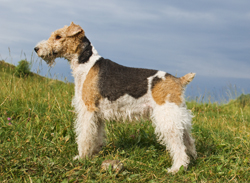Wire Fox Terriers are small dogs with predominantly white coats that may have black or tan markings. The coat is wiry, dense, and curly. These dogs have flat, broad heads, black noses, and long muzzles. Their ears are V-shaped and small, and their eyes are dark. Wire Fox Terriers should not exceed 15.5 inches tall at the shoulder and should weigh 18 pounds.
These dogs love to run, play, and explore, and they are overflowing with spirit and energy.
Friendly and playful dogs, Wire Fox Terriers make great companions for children and active families. They are bold, but never aggressive, and they make excellent watchdogs. These dogs love to run and play outdoors, and they need regular physical activity to remain mentally and physically healthy.
The Wire Fox Terrier and Smooth Fox Terrier were originally considered different versions of the same breed. In 1984, the breeds became separate.
Friendly, active, playful, and mischievous, the Wire Fox Terrier is always up for fun and adventure. These dogs love to run, play, and explore, and they are overflowing with spirit and energy. They make excellent companion animals for active families with children, and they form extremely strong bonds with family members. These dogs are happiest when spending the bulk of their time in the company of their human loved ones.
The breed's strong connection to family, natural courage, and loud bark make it a good watchdog. Wire Fox Terriers tend to be reserved around unfamiliar people and are very protective and loyal. They are also fearless and bold and are known for confronting larger dogs.
Wire Fox Terriers need daily exercise in the form of long walks, free play in a safe area, or vigorous play sessions. These dogs love to explore, chase, and hunt, and they must be kept on a leash or in a securely fenced yard when outdoors to keep them from wandering off. Their natural curiosity and love for hunting birds, squirrels, and other small creatures can get them into trouble.
Wire Fox Terriers are generally healthy dogs, but this is no guarantee that any individual dog will be free of genetic illness or other health problems. To help ensure a healthy adult dog, it is important to adopt or purchase Wire Fox Terriers only from reputable sources.
Legg-Calve-Perthes disease, shoulder dislocation, and patellar luxation are all seen in Wire Fox Terriers. These conditions may severely limit mobility and quality of life. Additionally, the breed is prone to a number of eye problems, including cataracts, lens luxation, and distichiasis. Deafness and skin allergies are also more common in this breed than in some other dogs.
With plenty of daily exercise, scheduled vaccinations, routine vet care, and proper nutrition, Wire Fox Terriers typically live a long and active life of up to 15 years.
A highly trainable breed, the Wire Fox Terrier responds well to positive reinforcement techniques and early training. These dogs do not do well when faced with harsh criticism or punishment. Training should be firm and consistent, and sessions should be short and fun.
Fortunately, Wire Fox Terriers are a generally well behaved breed. This does not mean they never act out, however. These spirited dogs need a productive outlet for their boundless energy to keep them from pursing more destructive outlets. Daily exercise will help keep inappropriate behaviors at bay.
Early socialization is an important part of caring for the Wire Fox Terrier. Without it, these dogs may grow up to be overly suspicious or fearful. Socialization will also teach them how to act around other animals. Early in life, these dogs should participate in puppy kindergarten and other age-appropriate activities. Later on, trips to the dog park and walks around town on a leash are good methods of socializing this breed.
Moderate grooming is necessary to keep the Wire Fox Terrier looking neat and attractive. These small dogs aren't big shedders, and a thorough coat combing every other day is generally sufficient to remove any tangles and loose hair. These dogs should be professionally shaped every few months by clipping or stripping the coat.
Bathing the Wire Fox Terrier is rarely necessary. This breed is relatively clean and only requires washing after getting into something sticky, stinky, or harmful. A gentle, pH-balanced shampoo will gently wash the coat without irritating or drying the skin. Rinsing thoroughly to remove all traces of soap reside is important.
The breed's teeth should be brushed every day or as often as possible. A canine toothpaste and toothbrush will help prevent gum disease, tooth decay, and bad breath. Additionally, these dogs should have their nails trimmed every couple of weeks and should undergo weekly ear exams to check for ear wax accumulation or signs of ear infection.
Wire Fox Terriers developed in the British Isles in the 17th century. Like many other terrier breeds, they descended from Rough Coated Black and Tan Terriers. They were originally bred to "go to ground," which involved chasing foxes and other animals from their dens.
Some question whether Smooth and Wire Fox Terriers developed from distinct backgrounds. The two were interbred at one time, primarily to improve the Wire variety by increasing the amount of white on the coat and decreasing the breed's size. Wire Fox Terriers did not enter the show ring until 15 or more years after the Smooth made its debut in the ring.
Wire Fox Terriers were extremely popular dogs following World War II. Then, in 1985, or about 100 years after the American Fox Terrier Club was established, the AKC split the fox terrier dogs into two separate breeds. Official standards for each were established in 1984.
The Wire Fox Terrier was officially recognized by the American Kennel Club in 1885.

